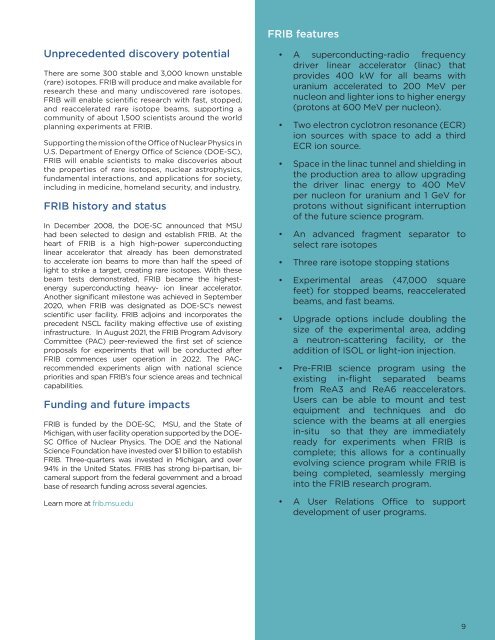202 FRIB Graduate Brochure
You also want an ePaper? Increase the reach of your titles
YUMPU automatically turns print PDFs into web optimized ePapers that Google loves.
<strong>FRIB</strong> features<br />
Unprecedented discovery potential<br />
There are some 300 stable and 3,000 known unstable<br />
(rare) isotopes. <strong>FRIB</strong> will produce and make available for<br />
research these and many undiscovered rare isotopes.<br />
<strong>FRIB</strong> will enable scientific research with fast, stopped,<br />
and reaccelerated rare isotope beams, supporting a<br />
community of about 1,500 scientists around the world<br />
planning experiments at <strong>FRIB</strong>.<br />
Supporting the mission of the Office of Nuclear Physics in<br />
U.S. Department of Energy Office of Science (DOE-SC),<br />
<strong>FRIB</strong> will enable scientists to make discoveries about<br />
the properties of rare isotopes, nuclear astrophysics,<br />
fundamental interactions, and applications for society,<br />
including in medicine, homeland security, and industry.<br />
<strong>FRIB</strong> history and status<br />
In December 2008, the DOE-SC announced that MSU<br />
had been selected to design and establish <strong>FRIB</strong>. At the<br />
heart of <strong>FRIB</strong> is a high high-power superconducting<br />
linear accelerator that already has been demonstrated<br />
to accelerate ion beams to more than half the speed of<br />
light to strike a target, creating rare isotopes. With these<br />
beam tests demonstrated, <strong>FRIB</strong> became the highestenergy<br />
superconducting heavy- ion linear accelerator.<br />
Another significant milestone was achieved in September<br />
<strong>202</strong>0, when <strong>FRIB</strong> was designated as DOE-SC’s newest<br />
scientific user facility. <strong>FRIB</strong> adjoins and incorporates the<br />
precedent NSCL facility making effective use of existing<br />
infrastructure. In August <strong>202</strong>1, the <strong>FRIB</strong> Program Advisory<br />
Committee (PAC) peer-reviewed the first set of science<br />
proposals for experiments that will be conducted after<br />
<strong>FRIB</strong> commences user operation in <strong>202</strong>2. The PACrecommended<br />
experiments align with national science<br />
priorities and span <strong>FRIB</strong>’s four science areas and technical<br />
capabilities.<br />
Funding and future impacts<br />
<strong>FRIB</strong> is funded by the DOE-SC, MSU, and the State of<br />
Michigan, with user facility operation supported by the DOE-<br />
SC Office of Nuclear Physics. The DOE and the National<br />
Science Foundation have invested over $1 billion to establish<br />
<strong>FRIB</strong>. Three-quarters was invested in Michigan, and over<br />
94% in the United States. <strong>FRIB</strong> has strong bi-partisan, bicameral<br />
support from the federal government and a broad<br />
base of research funding across several agencies.<br />
Learn more at frib.msu.edu<br />
• A superconducting-radio frequency<br />
driver linear accelerator (linac) that<br />
provides 400 kW for all beams with<br />
uranium accelerated to 200 MeV per<br />
nucleon and lighter ions to higher energy<br />
(protons at 600 MeV per nucleon).<br />
• Two electron cyclotron resonance (ECR)<br />
ion sources with space to add a third<br />
ECR ion source.<br />
• Space in the linac tunnel and shielding in<br />
the production area to allow upgrading<br />
the driver linac energy to 400 MeV<br />
per nucleon for uranium and 1 GeV for<br />
protons without significant interruption<br />
of the future science program.<br />
• An advanced fragment separator to<br />
select rare isotopes<br />
• Three rare isotope stopping stations<br />
• Experimental areas (47,000 square<br />
feet) for stopped beams, reaccelerated<br />
beams, and fast beams.<br />
• Upgrade options include doubling the<br />
size of the experimental area, adding<br />
a neutron-scattering facility, or the<br />
addition of ISOL or light-ion injection.<br />
• Pre-<strong>FRIB</strong> science program using the<br />
existing in-flight separated beams<br />
from ReA3 and ReA6 reaccelerators.<br />
Users can be able to mount and test<br />
equipment and techniques and do<br />
science with the beams at all energies<br />
in-situ so that they are immediately<br />
ready for experiments when <strong>FRIB</strong> is<br />
complete; this allows for a continually<br />
evolving science program while <strong>FRIB</strong> is<br />
being completed, seamlessly merging<br />
into the <strong>FRIB</strong> research program.<br />
• A User Relations Office to support<br />
development of user programs.<br />
9<br />
<strong>202</strong>2_<strong>FRIB</strong>_<strong>Graduate</strong>_<strong>Brochure</strong>v4.indd 9<br />
10/29/<strong>202</strong>1 3:33:28 PM






